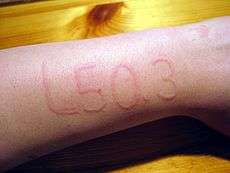Dermatographic urticaria
| Dermatographic urticarial D | |
|---|---|
 Dermatographic urticaria is sometimes called "skin writing". | |
| Classification and external resources | |
| Specialty | Dermatology, allergy and immunology |
| ICD-10 | L50.3 |
| ICD-9-CM | 708.3 |
| OMIM | 125635 |
| DiseasesDB | 12736 |
| eMedicine | derm/446 |
Dermatographic urticaria (also known as dermographism, dermatographism or "skin writing") is a skin disorder and one of the most common types of urticaria.[1][2]
Signs and symptoms
The symptoms are thought to be caused by mast cells in the surface of the skin releasing histamines without the presence of antigens, due to the presence of a weak membrane surrounding the mast cells. The histamines released cause the skin to swell in the affected areas.
This weak membrane easily and rapidly breaks down under physical pressure causing an allergic-like reaction, in general a red weal (welt) to appear on the skin. It can often be confused with an allergic reaction to the object causing the scratch, when in fact it is the act of being scratched that causes a weal to appear. These weals are a subset of urticaria (hives) that appear within minutes, in some cases accompanied by itching. The first outbreak of urticaria can lead to others on body parts not directly stimulated, scraped, or scratched. In a normal case, the swelling will decrease with no treatment within 15–30 minutes, but, in extreme cases, itchy red welts may last anywhere from a few hours to days.
Causes
The underlying cause of dermographism is not known, and can last for many years without relief. Five percent of chronic cases are never solved. Increased incidence has been observed following prolonged exposure to microwaves.[3][4] The condition may subside and be effectively cured; however, it is often a lifelong ailment. It is not a life-threatening disease and is not contagious.
Symptoms can be induced or worsened by periods of anxiety, physical stress, tight or abrasive clothing, watches, glasses, heat, cold,[5] or anything that causes stress to the skin.
Dermographism may occur in Mastocytosis (systemic mast cell proliferation).
Treatment
Dermographism can be treated by substances (i.e. an antihistamine) which prevent histamine from causing the reaction. These may need to be given as a combination of H1 antagonists, or possibly with an H2-receptor antagonist such as cimetidine.[6][7]
Not taking hot baths or showers may help if it is generalized (all over) and possibly for localized cases (in a specific area). If not taking hot showers helps, it may be a condition called shower eczema. If it affects mainly the head, it may be psoriasis. In rare cases, allergy tests may uncover substances the patient is allergic to. Using biodegradable or hypo-allergenic soaps and laundry supplies may help.
Using menthol mixed with aqueous cream is often an excellent temporary solution to help reduce irritation and itching in a localised area.
While cromoglycate, which prevents histamine from being released from mast cells, is used topically in rhinitis and asthma, it is not effective orally for treating chronic urticaria. Bug spray may also cause the skin reaction.[8][9]
Frequent anecdotal evidence suggests taking in small amounts of alcohol may help with the itching, or temporarily cause the inflammation/welts to subside.
Acupuncture and Chinese herbs have long been used to treat urticaria in Asia. Results of clinical trials of both acupuncture and Chinese herbs are inconclusive and are possibly a result of the placebo effect, as the trials did not involve a control group.[10][11][12]
See also
References
- ↑ Jedele, Kerry B.; Michels, Virginia V. (1991). "Familial dermographism". Am. J. Med. Genet. 39 (2): 201–203. doi:10.1002/ajmg.1320390216. PMID 2063925.

- ↑ Kontou-Fili, K.; Borici-Mazi, R.; Kapp, A.; Matjevic, L.J.; Mitchel, F.B. (1997). "Physical urticaria: classification and diagnostic guidelines. An EAACI position paper". Allergy 52 (5): 504–513. doi:10.1111/j.1398-9995.1997.tb02593.x. PMID 9201361.

- ↑ Sadčikova, M.N. (1973). Manifestations of Reactions to Microwave Irradiation in Various Occupational Groups (Scribd). Biologic Effects and Health Hazards of Microwave Radiation. Polish Medical Publishers. Retrieved December 23, 2013.

- ↑ Hocking, B. (February 2001). "Microwave sickness: a reappraisal". Occupational Medicine 51 (1): 66–69. PMID 11235831.

- ↑ Kaplan, Allan P. (1984). "Unusual cold-induced disorders: cold-dependent dermatographism and systemic cold urticaria". J Allergy Clin Immunol 73 (4): 453–6. doi:10.1016/0091-6749(84)90354-3. PMID 6200525.

- ↑ Wozel G, Sahre EM, Barth J (1990). "[Effectiveness of combination treatment with H1-(Tavegyl) and H2-antagonists (Altramet) in chronic/chronically-recurrent urticaria]". Dermatologische Monatsschrift (in German) 176 (11): 653–659. ISSN 0011-9083. OCLC 1566270. PMID 2083605.
- ↑ Negro-Álvarez, J.M.; Miralles-López, J.C. (2001). "Chronic idiopathic urticaria treatment". Allergologia et immunopathologia 29 (4): 129–132. doi:10.1016/S0301-0546(01)79045-3. ISSN 0301-0546. PMID 11674926.

- ↑ Thormann, J; Laurberg, G; Zachariae, H (March 1980). "Oral sodium cromoglycate in chronic urticaria". Allergy 35 (2): 139–41. doi:10.1111/j.1398-9995.1980.tb01728.x. PMID 6770707.

- ↑ Soter, Nicholas A. (December 1990). "Urticaria: current therapy". J. Allergy Clin. Immunol. 86 (6 Pt 2): 1009–1014. doi:10.1016/S0091-6749(05)80245-3. PMID 1979795.

- ↑ Jianli, Che (2006). "The Effect of Acupuncture on Serum IgE Level in Patients with Chronic Urticaria". J. Tradit. Chin. Medicine 26 (3): 189–190. PMID 17078446.

- ↑ Chen, Chung-Jen; Yu, Hsin-Su (1998). "Acupuncture Treatment of Urticaria". Arch. Dermatol. 134 (11): 1397–1399. doi:10.1001/archderm.134.11.1397. PMID 9828874.

- ↑ Kligler, Benjamin; Lee, Roberta A. (April 2004). Integrative Medicine: Principles for Practice. McGraw-Hill Professional. pp. 371–377. ISBN 9780071402392. OCLC 52257592.
| ||||||||||||||||||||||||||||||||||||||||||||